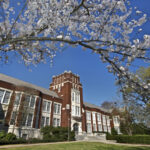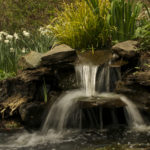Garden of Peace and Remembrance
A final resting place and sacred meeting space for all faiths and cultures
When the leader of a Catholic congregation wanted to create a sacred space to serve as a final resting place for not only his church members, but also for the immigrants and indigent of his community, his collaborative effort resulted in the Garden of Peace and Remembrance—for all faiths and cultures.
For years, Father Tuck Grinnell of St. Anthony of Padua Catholic Church in Falls Church, Virginia, dreamed of having a columbarium—a place to inter ashes—at his church. St. Anthony is in an immigrant community with many languages, ethnicities and religions. Many work hard to make ends meet and can’t afford to bury their loved —Father Grinnell wanted to do something about this.
The challenge was to take a space surrounded on three sides by the church and rectory and make it accessible to the entire community. But creating a truly open space within such a small, enclosed area wasn’t easy. It meant true collaboration with a multicultural community with many different opinions and creative design with a multifaceted approach. Father Grinnell called together fellow Firesouls, his church and community to create the design, and, with the help of Nature Sacred, it became a beautiful reality.
Open and inclusive
Pastoral counselor Pauline Flynn, architect Mario Pareja, master gardener and landscape designer Dorothy Schmidt and Father Grinnell worked hand-in-hand with the whole community to create an open garden free from specific religious icons, statues and symbols and full of non-denominational, universal appeal.

They chose a circle for the primary design element, because it is a symbol of inclusiveness, exists in civilizations worldwide and often is a focal point for gathering. And they wanted the Garden of Peace and Remembrance to be a gathering place for the whole community.
To have peace, you have to work together, whether you’re trying to create a garden or a world where people get along.
—Architect and Firesoul Mario Pareja.
They built a water fountain to represent peace. And peace became the garden’s theme. No matter how many times we’re knocked down in our quest for peace, we must get up and keep trying, just as rivers keep flowing. The fountain is made of rough-cut fieldstone, representing earth, hardship and the rough edges of humanity. It’s shaped like a beehive, naturally drawing people toward it. By leaning in, people become part of the peace fountain, instead of just spectators.

—Annonymous Journal Entry
Photo: Len Spoden
They considered using a granite plate for the fountain’s bottom, because glass is fragile and can break. But for that very reason—because peace is also fragile and can be broken—they chose glass. The word peace is engraved on it in 80 languages. Water flows over the glass and down the stone sides of the fountain into a pool, signifying that when peace is flowing into and out of our hearts, it can overcome any obstacle, just as water, over time, will smooth the roughness of stone.
The fountain sits slightly off-center in the garden for a reason. When people walk to the fountain, they’re actually closer to the garden’s center, symbolizing that humans are the central force in creating peace. In the well circling the bottom of the fountain are hundreds of glass pieces representing tears shed for all the times humans have been at odds or war with each other, rather than at peace.
The water alone is a soul soother. The sound of water gentles me.
—Anonymous Journal Entry
The garden’s path leads visitors through a colorful forest of peace poles, each one eight feet high and distinctively decorated by local public and private schools, religious communities, a youth group and a private individual, past the peace fountain and on to the columbarium in the back. Several benches for rest and reflection populate the path.

Safe and at peace
The Garden of Peace and Rembrance plantings—their colors, scents and textures—were carefully chosen to create the feeling of peace that people experience in this space. Round, full Yoshino cherry trees conceal the rectory wall behind them. English hornbeams, trees that grow vertically in a shape that suggests praying hands line the church walls. For Firesoul Pauline Flynn, the marvelous thing about the plantings and architecture is it all creates the feeling of being held in a closed space, safe and at peace. Yet, the garden is completely open and welcomes all—and that’s what makes it sacred to her.

A final resting place
Tucked in the back of the Garden of Peace and Remembrance is the columbarium for ashes. Mario created five vertical niches in the church wall finished in cypress, a very hard wood that has been used in many cultures and religions over time for burying people. The area surrounding the niches is finished with copper, again a symbolic choice. Copper is constantly changing in color as it ages over time. That change keeps the area, a resting place, alive and dynamic for the living who visit those who’ve passed.
The ache in my heart from the recent death of my father was soothed by the beauty and calm in this garden.
—Anonymous Journal Entry
Although in the courtyard of a Catholic church, the Garden of Peace and Remembrance has been welcoming visitors from all faiths and nationalities with symbols that are universally understood for decades. And Nature Sacred is grateful for helping make it happen.

—Anonymous Journal Entry




